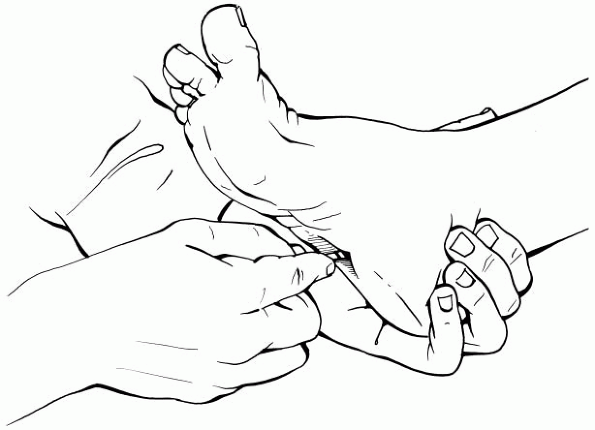Testing For the Babinski Response
– Neurologic Examination > Reflex Examination > Chapter 38 –
Testing For the Babinski Response
of the cerebral cortex (the upper motor neurons) and descend into the
opposite side of the spinal cord (see Chapter 24,
Approach to the Motor Examination). The corticospinal tracts have an
inhibitory influence on the Babinski sign; the inhibitory influence of
an intact corticospinal tract suppresses the Babinski sign entirely.
-
Testing for the Babinski response can be performed with the patient sitting or lying down. The patient’s foot should be relaxed.
-
With a blunt object, stroke the sole of
one foot, starting near the heel and proceeding forward along the
lateral sole. The maneuver should be performed in one smooth motion
over 1 or 2 seconds. Observe the response (particularly the response of
the big toe). -
Perform the same test on the other foot.
object results in flexion of the toes. This normal finding can be
reported as “no Babinski sign is present,” “plantar responses are
flexor bilaterally,” or “the toes are downgoing bilaterally.” Most
neurologists seem to prefer the “downgoing toes” terminology for the
normal response.
-
The abnormal finding on Babinski testing
is the Babinski sign itself. The Babinski sign consists of extension of
the big toe after the sole of the foot is stroked; this can occur with
or without fanning of the other toes (Fig. 38-1). -
The Babinski sign is an upper motor
neuron sign; it can occur due to any cause of corticospinal tract
dysfunction anywhere along its course, from its origin in the motor
cortex to its descent in the spinal cord. The Babinski
P.128
sign
occurs as a result of the loss of the normal inhibitory influence of
the corticospinal tract. Localizations suggested by the presence of
unilateral or bilateral Babinski signs are summarized in Table 36-1. -
The presence of a Babinski sign can be
reported in several ways. It can be reported as a “Babinski sign,” an
“extensor plantar response,” or an “upgoing toe.” Most neurologists
seem to prefer the “upgoing toe” terminology. -
The presence of a Babinski sign is always
abnormal; however, the decision as to whether the response seen is
truly a Babinski sign is not always so easy. It’s not uncommon for
patients to exhibit withdrawal to the plantar stimulus, consisting of
dorsiflexion of the foot and toes, which can look like a Babinski sign.
Babinski signs often consist of more subtle large toe dorsiflexion than
the marked foot and toe dorsiflexion commonly seen due to withdrawal.
Because the withdrawal reaction represents a ticklish response,
repeating the stimulus after reassuring the patient and asking the
patient to relax may help limit this reaction.
 |
|
Figure 38-1 The Babinski sign: extension of the big toe after the sole of the foot is stroked.
|
-
The Babinski sign is one of the most
important signs in neurology. Its presence, even without other signs of
upper motor neuron dysfunction, is an important clue to a corticospinal
tract lesion; however, the Babinski sign, like any other finding, needs
to be interpreted in the context of the patient’s whole clinical
picture. -
Many patients with Babinski signs have
only large toe dorsiflexion as their abnormal response. You don’t need
to see fanning of the toes for the patient to have a Babinski sign. -
If the patient has difficulty relaxing
the foot while you are performing the test, it’s helpful to take the
patient’s mind off the task by asking a historical question or simply
talking with the patient.
